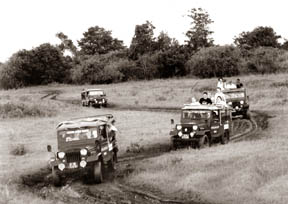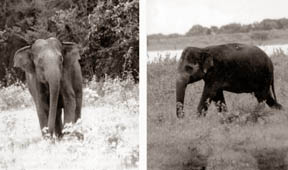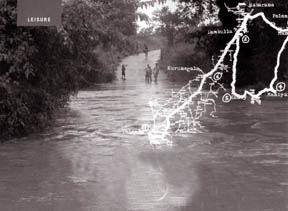|
observer |
|
|
|
|
|
OTHER LINKS |

|

|

|
Long way aroundDusk was settling in as we left Colombo. The mass exodus out of Colombo for the long weekend had already begun so after some tight manoeuvering along the Kaduwela road we arrived at Balumhara junction where a right turn brings us to a calmer and more serene Kandy road.
As we turn off the main road at Dambulla and join the road leading us to the Amaya Lake Eco Resort, we all start shuffling our feet in anticipation of getting off and stretching our weary bodies. We are greeted at the hotel with traditional garlands and modern warm towelettes. We dig into the first of many weekend buffets. The next morning we awake in our ecostyle village hut. We are soon in the buffet queue. On offer are a host of local dishes supplemented by western favourites. These are all washed down with liberal servings of fresh juices, coffee and tea. We then gather in the hotel lobby and set out on a trip to visit the vanniyala athos in Dambana. We soon find that rains from the previous night have made their imposing mark all around us. The locals tell us to use the other, 'longer' route. We turn around and head in the opposite direction past the hotel and are soon back on the familiar terra firma of asphalt. With cloudy skies forming and a strange darkness enveloping the area, we head towards Habarana and then further on the A11. At the Madakalapuwa junction just before the bridge in Manampitiya (the only bridge to also have an intersecting railtrack on it) we discover the entire stretch of road before us is flooded up to four feet. After a brief inspection we boldly begin to move forward, cameras in hand. As we begin our slow progress, the water soon rushes up towards the door level of our vehicle, bringing on a sense of excitement and fear. We keep steadily moving forward, everyone inside the vehicle looking on in anticipation, as we eventually reach dry land once again.
The simplicity of the shop is astounding, and also reflective of the attitude of the people of this area. They have very little in terms of needs or wants and continue to live exuberant day-to-day lives. The hearth comprises a traditional firewood stove with a silver metallic jug (kalaya) being used to boil water. A cat sleeps next to the stove, revelling in the heat and using the layer upon layer of ash as a mattress. Generous servings of plain tea were gulped down and after taking a few photographs we were on the road again. Further along, we see the Dimbulagala temple. It sits upon the crest of a mountain and is very picturesque and the flapping flags that surround the temple shrine (stupa) present a very spiritual ambience. We look up, slow down and then look forward and drive on. As we draw near to Mahiyanganaya the rain still shows no signs of easing. Well into the wet zone, tall trees that arch into the road soon surround us. These continuous lines of trees on either side, fully leaved, create a beautiful aisle as we travel down the road. We arrive at Mahiyanganaya and head towards Dambana. Dambana brings an unusual commercialism to this part of Sri Lanka. Before you know it, we see lots of other out of town day trippers, and vanniyala athos prancing up and down the access road, offering themselves for pictures, hawking small wooden axes and selling fresh honey in 'arrack' bottles. After spending a few hours meeting them we drive off with dust rising in the background.In these parts life is unhurried and carefree, making us realize that us city folk have a lot to learn from them. With the cloud-covered sun making a hasty retreat and the rain still pouring down we head back towards Mahiyanganaya. We ask at a military checkpoint and are told to proceed along a new Japanese funded road. Upon reaching the road, another checkpoint flags us down and informs us that previous flooded stretches are now no longer accessible to any type of vehicle. This means the only way back to our hotel in Dambulla was through Kandy, a good 145 kms away in a western direction.
We are soon leaving Mahiyanganaya behind us and travelling towards the nation's hill capital Kandy. On the way we begin our ascent of the infamous 18 bends (daha ata vangu), this is a swirling road that winds up towards Kandy. It has eighteen notoriously sharp bends and offers a challenge to even the most skilful of drivers. We soon arrive in Kandy and park along the banks of the lake to take some stunning night time pictures of a magnificently lit temple of the tooth relic the Dalada Maligawa. After stocking up on caffeine and snacks from the supermarket, the only snack market open at that time of the night, we arrive in Katugasthota as the clock strikes midnight. We stop at a small night shop by the banks of the Mahaweli river. Here we dine on local eatery favourites. The final leg of the days' travels take us through the towns of Akurana and Matale along the A9, eventually reaching Dambulla, the hotel and the familiar sight of much-longed for beds. The next day we are woken up by the sounds of some nearby egrets. We all proceed to the nearby authentic village type eatery within the hotel premises. While we discuss the happenings of the previous day we ate a good old Sri Lankan buffet of string hoppers, pittu and bread with chicken, fish and dhal curries with pol sambol on the side.
We all stand up and take a look out-side the jeep and enjoy the feeling of wind rushing through our hair. Suddenly we see it a magnificent adult male elephant on the wayside, eating. This is the first of many elephants that we see along this road. Around 10 kilometres from Habarana a right turn off the 'male para' brings you to the entrance of Kaudulla National Park. We enter the park by crossing a bridge, hiding a river swollen from the previous day's rain. Persistent clouds partially hide the sun. Thilak tells us that in the evening elephants congregate around the Kaudulla tank. We proceed to drive across the rough terrain, a mixture of grass and rainwater. The result is mud, and lots of it. The driver of the jeep carries on regardless, driving through the mud filled dips. The wheels travel in one direction while the body of the jeep proceeds in another. We are shaken from left to right, occasionally bumping against the tough metal frame. This however is a small price to pay as we witnessed dozens of wild elephants in their natural habitat - walking near the tank, eating, drinking and resting. The highlight of the trip was when a calf broke from its herd and entered the tank. At first we assumed it was for a mere soaking of the feet, but as we waited and watched, the calf delved deeper and deeper into the depths of the tank. And so we all glued our eyes as the calf embarked on a swim. It was at one point completely submerged, but soon returned to the surface. We watched as the calf finished its bath, and returned to the banks of the tank, where its herd waited patiently. It was indeed a rare sight, even to the most experienced nature lover. As we continued driving through the park, we saw a lone elephant, momentarily blocking our path as he stood directly in front of us, but soon after a huff and puff, stepped aside into the bushes and let us carry on. With darkness rapidly descending, we soon were nearing the entrance of Kaudulla park and before we knew it the safari was over. We are now back on the 'male road', the darkness and breeze brings on a sense of soothing calmness, but this is short lived as we see an elephant in the headlights. Lone elephants can often be unpredictable, but this elephant stayed by the side of the road watching us. Perhaps lost, perhaps hungry, perhaps left behind. We stop briefly, then carry on again down, back to Habarana. Back at the hotel around the dinner table we exchange tales from our afternoon's journey. After dinner we head back to our rooms. The nation sleeps in on a Sunday. This was no different for us, after a very generous lie-in, we packed our bags and headed for breakfast. Everyone was unusually silent as we ate and then went for a leisurely stroll around the hotel compound. We took time to trod our feet in the Kandalama tank. We head back to our rooms for a shower and change of clothes and then assemble by the reception with all our bags, trinkets and other possessions. We bid farewell to the staff, and then begin our journey back to Colombo. |
 With the sun slowly sinking behind us we entered into the darkness of
night. Without much argument, whatever was on the radio via an iPod was
welcomed and enjoyed. The first stop in our journey was at the Ambepussa
rest house, not the traditional old one to the left of the road, but the
more modern setting on the right. After digesting fish buns (malu paan)
and hot tea we again set off on the road making a right turn just past
the rest house, on the road that leads to Kurunegala and eventually to
our final destination - Dambulla.
With the sun slowly sinking behind us we entered into the darkness of
night. Without much argument, whatever was on the radio via an iPod was
welcomed and enjoyed. The first stop in our journey was at the Ambepussa
rest house, not the traditional old one to the left of the road, but the
more modern setting on the right. After digesting fish buns (malu paan)
and hot tea we again set off on the road making a right turn just past
the rest house, on the road that leads to Kurunegala and eventually to
our final destination - Dambulla.  As we proceed down the A11 the surrounding environment takes on more
foliage as we travel from the dry to the wet zone. We make a brief stop
at a roadside shop in the town of Bandanagala. The shop-keeper and her
family welcome us and we are offered parippu vade and kalu dodol.
As we proceed down the A11 the surrounding environment takes on more
foliage as we travel from the dry to the wet zone. We make a brief stop
at a roadside shop in the town of Bandanagala. The shop-keeper and her
family welcome us and we are offered parippu vade and kalu dodol.  We agree to somehow carry on driving through the night, even if it
means going through Kandy. We re-invigorate ourselves with a meal at a
local eatery. Bowls of chicken and dhal curry are combined with fresh
crusty bakery bread. We ask for tea, some with added ginger.
We agree to somehow carry on driving through the night, even if it
means going through Kandy. We re-invigorate ourselves with a meal at a
local eatery. Bowls of chicken and dhal curry are combined with fresh
crusty bakery bread. We ask for tea, some with added ginger.  After resting and reassembling for a far more simple lunch, we were
soon on the road again. The rain had subsided, but the clouds were still
threateningly present. We reach Habarana where we enlist the services of
veteran wildlife guide Thilak. After transferring to a more rugged
safari jeep we drive down the 'male para', the name given to the road
that leads up to the town of Trincomalee. As we leave behind the town of
Habarana and head north the scenery undergoes a drastic change from the
bricks and tiles of Habarana town to lush plateaus and fields full of
greenery.
After resting and reassembling for a far more simple lunch, we were
soon on the road again. The rain had subsided, but the clouds were still
threateningly present. We reach Habarana where we enlist the services of
veteran wildlife guide Thilak. After transferring to a more rugged
safari jeep we drive down the 'male para', the name given to the road
that leads up to the town of Trincomalee. As we leave behind the town of
Habarana and head north the scenery undergoes a drastic change from the
bricks and tiles of Habarana town to lush plateaus and fields full of
greenery. 







